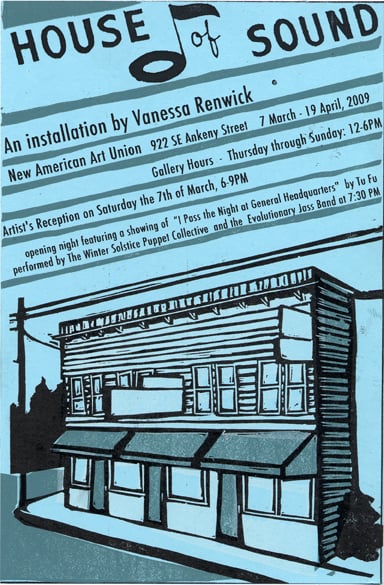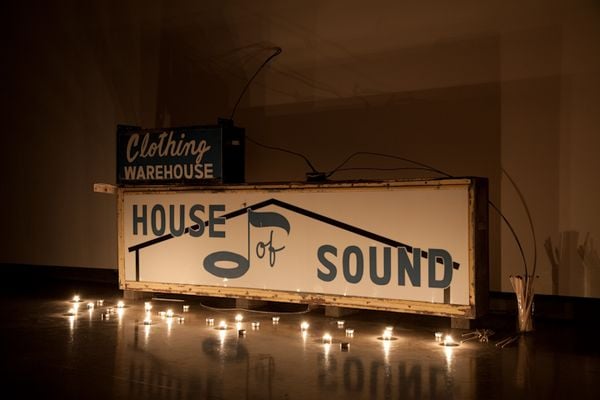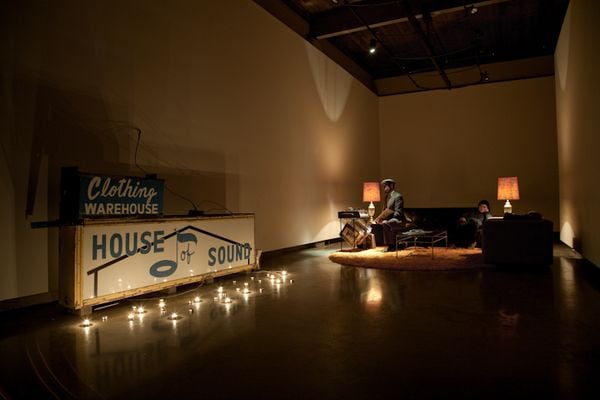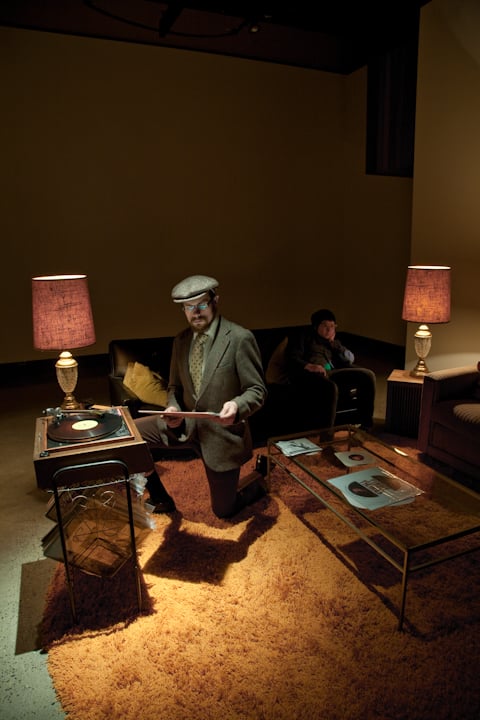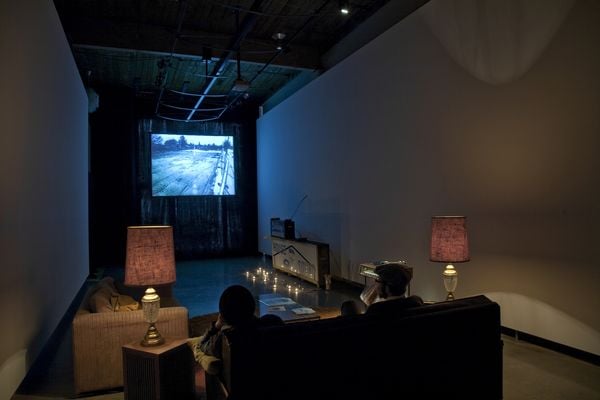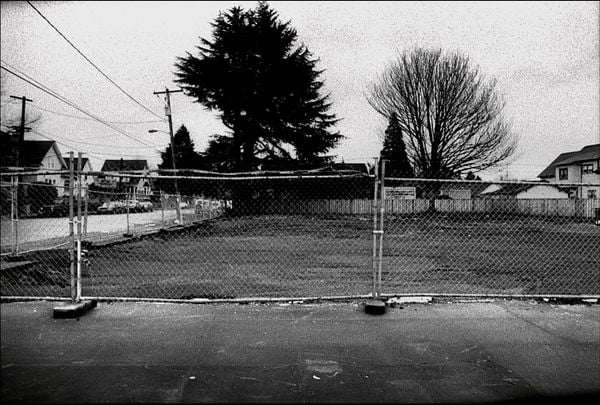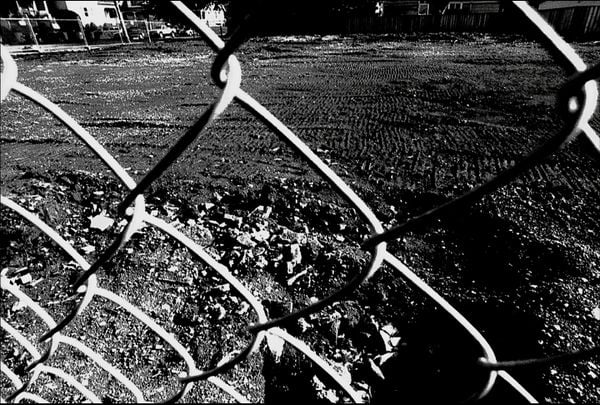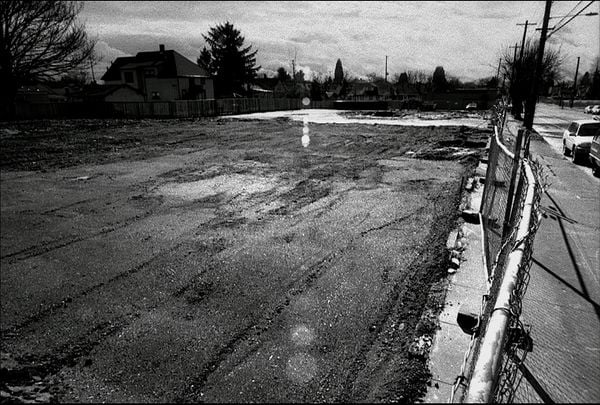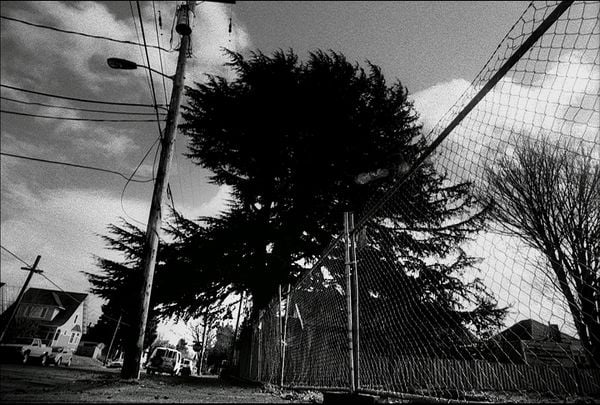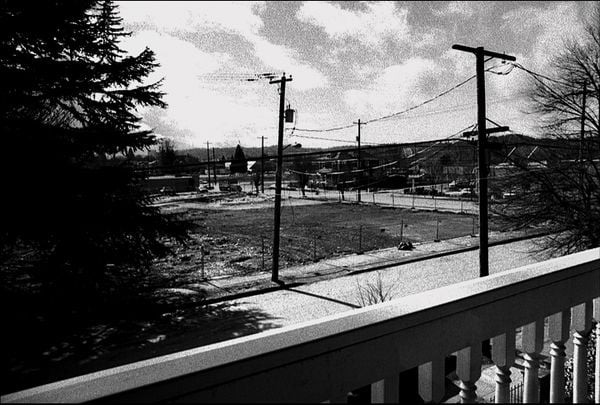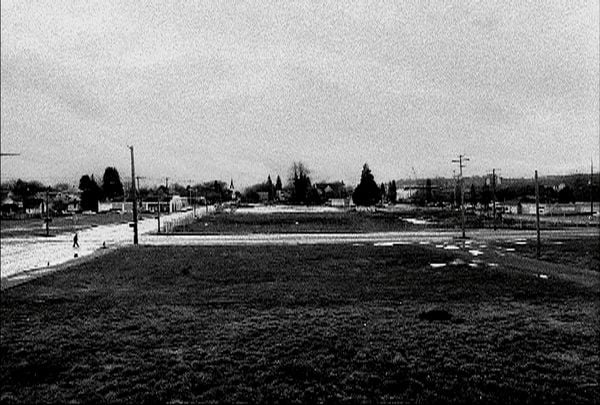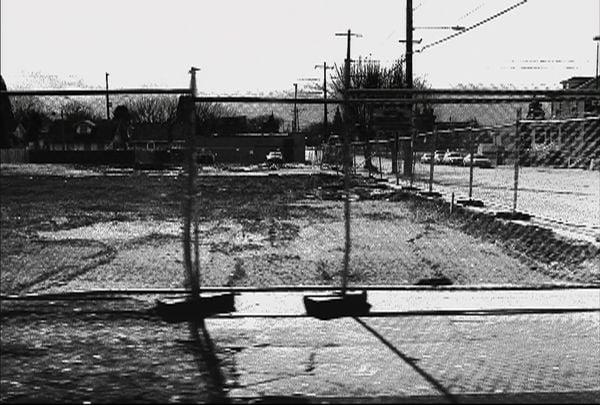The House of Sound
2009, video installation, 2-channel audio, 35mm B&W film to HD, plexiglass, metal,candles, couches, coffee, table, rug, record stand, LPs, 45s, turntable.
synopsis:
In the 1950s, Williams Avenue had the most significant concentration of blacks living in Portland. In the late ‘50s, pushing an ‘urban renewal’ policy and exercising the power of eminent domain, the Portland City Council condemned almost the entire neighborhood to replace it with the Memorial Coliseum, Rose Quarter and Emmanuel Hospital. With film and an edited 5-hour radio show dedicated to the memory of the House of Sound record store, this installation is a eulogy for the former community center and for all the places up and down the street that used to fill those empty lots, now unrecognizable as mixed-use, high-rise hyper-urban development.
A cozy living room features couches and a turntable where visitors are welcome to make themselves at home among the vinyl collections of the previous century. Beyond, votive candles surround the iconic storefront sign, ‘House of Sound’ in distinctive lettering and decorated with musical notes, while at the back of the room a screen portrays black and white images of the desolated neighborhood after the December 31, 2008 demolition of the building that housed the record store and cultural heart of Portland’s historic black neighborhood.
credits:
cinematography: Eric Edwards
edit: Rankin Renwick
online edit: Tim Scotten
premiere:
Installed at New American Art Union
March 7-April 18
made with support from Ruth Anne Brown and the Regional Arts and Culture Council
Opening reception featured the 2008 Winter Solstice Puppet Collective performing the shadow play
‘I Spend the Night At General Headquarters’ based on the poem by Tu Fu, translated by Kenneth Roxroth.
review:
House of Sound
by Jon Raymond
Like the song says: you don’t know what you’ve got ‘til it’s gone.
We know this is true, more or less. We feel it whenever we say goodbye to our friends and loved ones at the end of the night. We sense it in the aging buildings we walk past on the street. We see it in our own thinning pants. Everyday, this minor shock of sorrow is available, a dim background awareness of time’s passage, and a vague comprehension of the demonic, inverse ratio between a thing’s presence in our lives and its preciousness in our minds. As things fade from view, they assume a final shape, and sweeten in the honeycomb of memory.
Joni Mitchell made a hectoring folk song of the sentiment. She seems to think we could know what we’ve got before it’s gone, and the fact that we don’t is a matter of our own lousy morals. A harder truth to consider, though, is the one that suggests we literally cannot know; that we are physically barred from comprehending the value of what we adore until the moment it ceases to exist. It is only in the presence of death, absence, that the heart really opens.
Rankin Renwick, filmmaker, installation artist, mother, and activist, brings us to this hard truth with some regularity. In a series of artworks over the past decade she has bravely eulogized the passing of such unlikely public objects as traffic onramps, nuclear reactors, and civil rights protections in the Bush-Cheney era, allowing viewers the chance to note whatever lingering anger, resignation, bitterness, or euphoria these respective disappearances might imply. In “Clearcut,” for example, the artist documents the destruction of public murals largely taken for granted until their final moments of existence. In “Portrait #2: Trojan” she records (with the help of cameraman Eric Edwards) the implosion of a mothballed nuclear plant, an unloved monument that is now, nonetheless, perversely missed.
The most recent object of Renwick’s attention is the dearly departed building on the corner of Beech and Williams that once housed the House of Sound, a record store, community anchor, and landmark for passersby. Founded in1964, the store was itself the remnant of a nearly mythic neighborhood in the city’s history, a strip of black jazz clubs that evaporated with the development of Memorial Coliseum and Emanuel Hospital in the area. In retrospect, the lost neighborhood has come to seem like a flashing sliver of Harlem itself, a beacon of livelier, more colorful times in a part of town only recently rediscovered by developers.
Renwick’s response to the loss of the House of Sound is characteristically stalwart and unintrusive. Like a kind of hospice nurse of community architecture, she has quietly tended the patient, dressing its wounds, cleaning its body, making room for relatives to view the remains. She has collected family histories and arranged the services. Here, now, the sign rests, surrounded by votive candles, as ghostly images and voices, remembering, float in the air.
What is there to say, though? The House of Sound is gone. It’s a fact we have to deal with, as we deal with any number of unhappy changes in life. The loss is not exactly tragic-"another wrecked building in the constant wreckage of the city’s upward progress-"but to let it go unrecognized would have been. Thanks to Renwick, we are at least allowed a moment to mark the passage. Thanks to Renwick, the preservationist, we are granted the dignity of mourning.
Audio was edited down from a special 5-hour show dedicated to the House of Sound, which aired on February 14th 2009 on Jazz Rap 2, hosted by Yugen Fardan Rashad on KBOO. The radio show was Vanessa Renwick's idea.
Guests on the show were David Dawson, Cleo Smith, Woodrow Wilson Jr., Billy Holt, Mr. Wone and Vanessa Renwick.
There is a combined package which includes an 80 minute audio CD edited by Erin Yankee, with the DVD of the film, available for purchase through Mississippi Records.
The House of Sound sign was split into two different signs, since it was a two-sided light box sign. One side hung inside Geneva's Shear Perfection at 5601 NE Martin Luther King Jr. Boulevard.,until they closed. It was then moved to Charles Bedford’s Going Street Market at 4601 N. Williams Avenue. Charles used to work at The House of Sound.The other side is up at Mississippi Records at 5202 N. Albina, which supplied the turntable, speakers and records for this show.
The House of Sound
A video installation by Rankin Renwick
Empty, empty, empty lots.
In the 1950’s Williams Avenue had the most significant concentration of Blacks living in Portland. In the late 50’s the city council condemned almost the entire black neighborhood to use the land to build the Memorial Coliseum, Rose Quarter and Emmanuel Hospital.
In the last 2 decades since she moved to Portland, Rankin Renwick has witnessed many remaining black owned businesses closing up shop, and their buildings being torn down. Williams Avenue is once again full of empty lots. At the moment, with the recession going on, there are a string of empty lots on Williams with no development happening. A huge expanse of gone. It is now a route of the unknown.
One building recently demolished on New Years Eve 2008 was the iconic 2 story building on the corner of Williams and Beech. This building housed a barbershop, a grocery store and a record store called the House of Sound. The House of Sound was an important social gathering place, and even after the business had closed, the empty building itself had an uncanny strong pull to many.
Through film and recorded memories of the people who used to own and work at the House of Sound, this installation is a eulogy for the House of Sound, for places that used to fill those empty lots. For a community that is once again being “moved along”. To take stock of what we are losing in this new wave of development.

